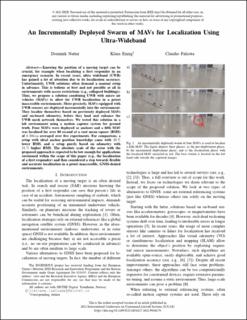| dc.description.abstract | Knowing the position of a moving target can be crucial, for example when localizing a first responder in an emergency scenario. In recent years, ultra wideband (UWB) has gained a lot of attention due to its localization accuracy. Unfortunately, UWB solutions often demand a manual setup in advance. This is tedious at best and not possible at all in environments with access restrictions (e.g., collapsed buildings). Thus, we propose a solution combining UWB with micro air vehicles (MAVs) to allow for UWB localization in a priori inaccessible environments. More precisely, MAVs equipped with UWB sensors are deployed incrementally into the environment. They localize themselves based on previously deployed MAVs and on-board odometry, before they land and enhance the UWB mesh network themselves. We tested this solution in a lab environment using a motion capture system for ground truth. Four MAVs were deployed as anchors and a fifth MAV was localized for over 80 second at a root mean square (RMS) of 0.206 m averaged over five experiments. For comparison, a setup with ideal anchor position knowledge came with 20 % lower RMS, and a setup purely based on odometry with 81 % higher RMS. The absolute scale of the error with the proposed approach is expected to be low enough for applications envisioned within the scope of this paper (e.g., the localization of a first responder) and thus considered a step towards flexible and accurate localization in a priori inaccessible, GNSS-denied environments. | en_US |
